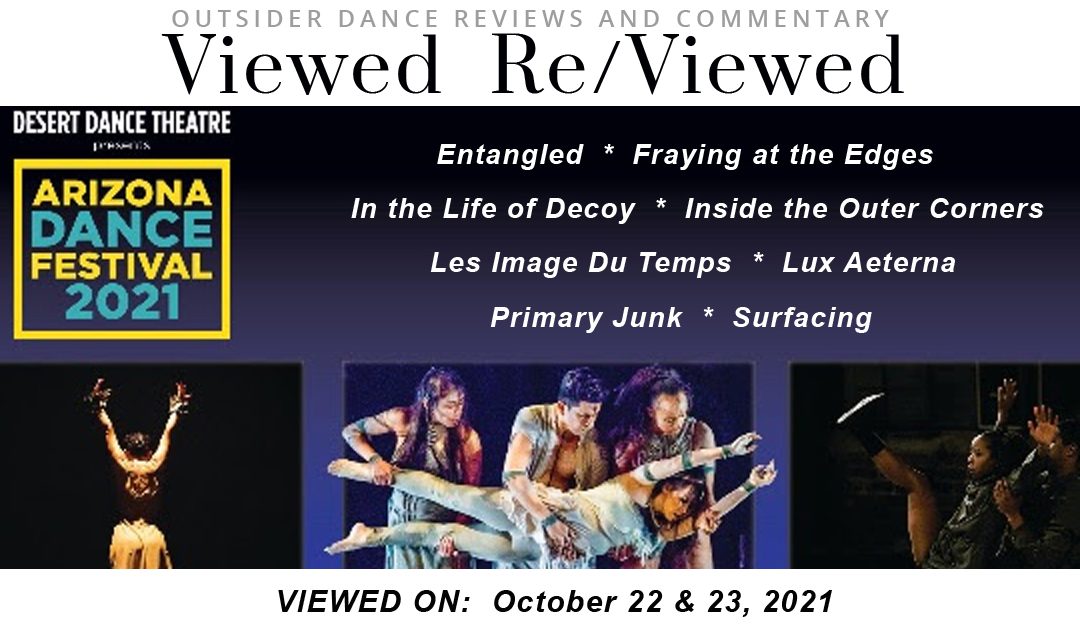Company: Diane McNeal Hunt / Elevate DanceWorks
Choreographer: Diane McNeal Hunt
Performer: Margie Romero Wolf
In commemorating the passing of Deborah Pualani Blackmon, who was long associated with the local dance community, choreographer Diane McNeal Hunt seems to understand that our intellect is a poor translator for the emotions taking up residence deep in our bones.
There is a language of grief so shopworn as to be banal. However sincere, the words are unfelt at the most primary and important levels. It is at moments like this that we feel the inadequacy of language itself. Even poetry, with all its purported power, can fail to express the inexpressible.
McNeal Hunt’s language – dance, is perhaps the only way to communicate what she and her community could not adequately say but certainly feel. In Lux Aeterna she uses the body itself to express the ephemeral, the sadness and the reverence felt by the community the departed leaves behind.
I never felt an abandonment to inchoate grief in this performance – a commonplace element in many impassioned dance solos. It’s ironic that in this memorial, the one place it could appear without being perceived as an overwrought cliché, McNeal Hunt has chosen to avoid it altogether. She has termed this an “artistic blessing”, though a deep and abiding sorrow and sense of loss are everywhere evident in the performance. However, this never collapses into a consuming misery and repeatedly looks beyond – for what we do not know, but feel the mourner’s ache to see the unseen and touch what is absent.
There is a repeated gesture, a thematic element created by an outthrust arm, hand extended, palm vertical. It is a piercing thrust – a strong and determined attempt to reach beyond the self. Whether it is releasing the spirit or attempting to touch the mystery – I can’t tell. I can’t explain it but I can feel it and therein lies the sublime nature of dance.
The piece employs a single, large, box-like prop, which I assume to be a sepulcher – but whether tomb or monument, it embodies the presence of the departed and is a focal point and touchstone for the mourner as she transitions between interior feelings, external expressions and attempts to communicate directly with the departed -as she does when she respectfully approaches it, or laments over the object or physically mounts it in an attempt to reestablish a connection. The “other” has been given a physical location that guides our perception of the performance.
I was taken by a brief but powerful moment when the mourner throws her face back with outthrust arms and arches her back, as if baring her breast to the sky. It was not supplication, not praise – more akin to surrender but something more profound, like opening her breaking heart to the heavens.
When, near the ending, she mounts and stands upright on the sepulcher, it feels like she is assuming another identity – transitioning from the mourner to the embodiment of the departed
This moment produced the most poignant and telling gesture of the program – which was also perhaps the smallest. Romero Wolf’s hand begins a slow, descending, twisting motion – like a dying leaf, succumbing at last to gravity and spiraling toward the ground. But its slow, fluttering descent is interrupted by that same fierce, piercing gesture, hand outstretched like an arrow, pointing to something beyond itself, beyond this life to an unknowable, unspeakable truth.
Lux Aeterna, a commemoration of the passing of Deborah Pualani Blackmon, was a mature work, fittingly conceived and performed by her peers. Diane McNeal Hunt’s choreography and its performance by Margie Romero Wolf, managed to balance grief with longing. It was a complex vision that acknowledged sorrow but did not become victim to it, always moving toward the “other” in pursuit of the mystery of the spirit.
Viewed Re/Viewed


Thank you SO much for this sincere and wonderful review that eloquently articulated what I too experienced watching this moving tribute to Deborah! I have been a member of Desert Dance Theatre for many years and we are all deeply grieving her loss. Diane did such a magnificent job of capturing the depth of our grief that I found myself choking back sobs during the performance. Losing someone during COVID added an additional layer of pain as it was not safe to gather in a timely manner to help process the grief. Thank you again for acknowledging Diane’s work and the power of dance!